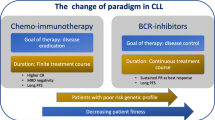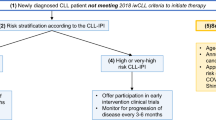Summary
Chronic lymphocytic leukaemia (CLL) in early stages does not require immediate treatment. Although some patients progress rapidly, institution of treatment in an asymptomatic phase has so far not been demonstrated to be beneficial and is best deferred to the time of disease progression. Some early stage patients do not progress for a prolonged period of time and may indeed never need treatment. For patients requiring treatment, risk-adapted strategies have been defined in recent trials. Importantly, age itself should not be used to preclude patients from more intensive protocols, with performance status and presence or absence of co-morbidities being the recommended criteria for treatment adjustments. Whilst fitter patients without significant co-morbidity are initially best treated with immunochemotherapy protocols, aiming at achieving maximum tumour reduction and a status of negativity for minimal residual disease (MRD), less intensive strategies seem to be preferable for the less fit, "slow-go" patient. The CLL8 study has now set the current standard for first-line treatment of the "go-go" patient, showing that rituximab + fludarabine and cyclophosphamide (R–FC) improve not only response rates and progression-free survival as compared to fludarabine and cyclophosphamide (FC), but also overall survival. Currently, studies are ongoing trying to further improve over this standard. For patients with co-morbidity, chlorambucil might still be a valuable treatment option. Initial results of ongoing studies seem to indicate that outcome might be further improved by combination of this drug with rituximab. Combination protocols and lenalidomide are currently investigated for their therapeutic efficacy in "go-go" as well as "slow-go" patients. Cytogenetic and biological characteristics of the disease are also getting increasingly important for treatment selection. Currently, CLL cases with 17p deletion are defined as separate subgroup, with poor response to fludarabine- and alkylator-based chemotherapy protocols and also only poor results achievable by R–FC. For this high-risk patient group, alemtuzumab including combination treatments are recommended and for selected patients, several groups are testing a strategy using allogeneic transplantation with full or reduced intensity conditioning.
Similar content being viewed by others
References
Hallek M, Cheson BD, Catovsky D, et al. Guidelines for the diagnosis and treatment of chronic lymphocytic leukemia: a report from the International Workshop on Chronic Lymphocytic Leukemia updating the National Cancer Institute-Working Group 1996 Guidelines. Blood, 11: 5446–5456, 2008
Hallek M. State-of-the-art treatment of chronic lymphocytic leukemia. Hematol Am Soc Hematol Educ Program, 440–449, 2009
Hallek M, Fingerle-Rowson G, Fink AM, et al. First-line treatment with fludarabine (F), cyclophosphamide (C), and rituximab (R) (FCR) improves overall survival (OS) in previously untreated patients (pts) with advanced chronic lymphocytic leukemia (CLL): results of a randomized phase III trial on behalf of an International Group of Investigators and the German CLL Study Group. Blood (ASH Annual Meeting Abstracts), 114: 535, 2009
Hallek M, Fingerle-Rowson G, Fink AM, et al. Immunochemotherapy with fludarabine (F), cyclophosphamide (C), and rituximab (R) (FCR) versus fludarabine and cyclophosphamide (FC) improves response rates and progression-free survival (PFS) of previously untreated patients (pts) with advanced chronic lymphocytic leukemia (CLL). Blood (ASH Annual Meeting Abstracts), 112: 325, 2008
van Oers MH, Klasa R, Marcus RE, et al. Rituximab maintenance improves clinical outcome of relapsed/resistant follicular non-Hodgkin lymphoma in patients both with and without rituximab during induction: results of a prospective randomized phase 3 intergroup trial. Blood, 108: 3295–3301, 2006
Schweighofer CD, Ritgen M, Eichhorst BF, et al. Consolidation with alemtuzumab improves progression-free survival in patients with chronic lymphocytic leukaemia (CLL) in first remission: long-term follow-up of a randomized phase III trial of the German CLL Study Group (GCLLSG). Br J Haematol, 144: 95–98, 2009
Hainsworth JD, Vazquez ER, Spigel DR, et al. Combination therapy with fludarabine and rituximab followed by alemtuzumab in the first-line treatment of patients with chronic lymphocytic leukemia or small lymphocytic lymphoma: a phase 2 trial of the Minnie Pearl Cancer Research Network. Cancer, 112: 1288–1295, 2008
Wendtner CM, Ritgen M, Schweighofer CD, et al. Consolidation with alemtuzumab in patients with chronic lymphocytic leukemia (CLL) in first remission – experience on safety and efficacy within a randomized multicenter phase III trial of the German CLL Study Group (GCLLSG). Leukemia, 18: 1093–1101, 2004
Fischer K, Cramer P, Stilgenbauer S et al. Bendamustine combined with rituximab (BR) in first-line therapy of advanced CLL: a multicenter phase II trial of the German CLL Study Group (GCLLSG). Blood (ASH Annual Meeting Abstracts), 114: 205, 2009
Fischer K, Stilgenbauer S, Schweighofer CD, et al. Bendamustine in combination with rituximab (BR) for patients with relapsed chronic lymphocytic leukemia (CLL): a multicentre phase II trial of the German CLL Study Group (GCLLSG). Blood (ASH Annual Meeting Abstracts), 112: 330, 2008
Eichhorst BF, Busch R, Stilgenbauer S, et al. First-line therapy with fludarabine compared with chlorambucil does not result in a major benefit for elderly patients with advanced chronic lymphocytic leukemia. Blood, 114: 3382–3391, 2009
Hillmen P, Gribben JG, Follows GA, et al. An open-label phase II study to investigate the safety and efficacy of rituximab plus chlorambucil in previously untreated patients with CD20-positive B-cell chronic lymphocytic leukaemia (CLL). Blood (ASH Annual Meeting Abstracts), 114: 3428, 2009
Chen C, Paul H, Xu W, et al. A phase II study of lenalidomide in previously untreated, symptomatic chronic lymphocytic leukemia (CLL). Blood (ASH Annual Meeting Abstracts), 112: 44, 2008
Ferrajoli A, O'Brien S, Wierda W, et al. Lenalidomide as initial treatment of elderly patients with chronic lymphocytic leukemia (CLL). Blood (ASH Annual Meeting Abstracts), 112: 45, 2008
Chanan-Khan A, Miller KC, Musial L, et al. Clinical efficacy of lenalidomide in patients with relapsed or refractory chronic lymphocytic leukemia: results of a phase II study. J Clin Oncol, 24: 5343–5349, 2006
Ferrajoli A, Lee BN, Schlette EJ, et al. Lenalidomide induces complete and partial remissions in patients with relapsed and refractory chronic lymphocytic leukemia. Blood, 111: 5291–5297, 2008
Andritsos LA, Johnson AJ, Lozanski G, et al. Higher doses of lenalidomide are associated with unacceptable toxicity including life-threatening tumor flare in patients with chronic lymphocytic leukemia. J Clin Oncol, 26: 2519–2525, 2008
Ferrajoli A, Badoux XC, O'Brien S, et al. Combination therapy with lenalidomide and rituximab in patients with relapsed chronic lymphocytic leukemia (CLL). Blood (ASH Annual Meeting Abstracts), 114: 206, 2009
Egle A, Steurer M, Melchardt M, et al. The REVLIRIT CLL5 AGMT Study – a phase I/II trial combining fludarabine/rituximab with escalating doses of lenalidomide followed by rituximab/lenalidomide in untreated chronic lymphocytic leukemia (CLL): results of a planned interim analysis. Blood (ASH Annual Meeting Abstracts), 114: 3453, 2009
Lepretre S, Aurran T, Mahe B, et al. Immunochemotherapy with fludarabine (F), cyclophosphamide (C), and rituximab (R) (FCR) versus fludarabine (F), cyclophosphamide (C) and mabCampath (Cam) (FCCam) in previously untreated patients (pts) with advanced B-chronic lymphocytic leukemia (B-CLL): experience on safety and efficacy within a randomised multicenter phase III trial of the French cooperative group on CLL and WM (FCGCLL/MW) and the "Groupe Ouest-Est d'Etudes Des Leucémies Aigües Et Autres Maladies Du sang" (GOELAMS): CLL2007FMP (for fit medically patients). Blood (ASH Annual Meeting Abstracts), 114: 538, 2009
Sher T, Miller KC, Lawrence D, et al. Efficacy of lenalidomide in patients with chronic lymphocytic leukemia with high-risk cytogenetics. Leuk Lymphoma, 51: 85–88, 2010
Knauf WU, Lissichkov T, Aldaoud A, et al. Phase III randomized study of bendamustine compared with chlorambucil in previously untreated patients with chronic lymphocytic leukemia. J Clin Oncol, 27: 4378–4384, 2009
Foon KA, Boyiadzis M, Land SR, et al. Chemoimmunotherapy with low-dose fludarabine and cyclophosphamide and high dose rituximab in previously untreated patients with chronic lymphocytic leukemia. J Clin Oncol, 27: 498–503, 2009
Engert A, Gercheva L, Robak T, et al. Improved progression-free survival (PFS) of alemtuzumab (Campath®, MabCampath®) plus fludarabine (Fludara®) versus fludarabine alone as second-line treatment of patients with B-cell chronic lymphocytic leukemia: preliminary results from a phase III randomized trial. Blood (ASH Annual Meeting Abstracts), 114: 537, 2009
Michallet M, Dreger P, Sutton L, et al. Autologous hematopoietic stem cell transplantation (autoHSCT) in CLL: first results of an EBMT randomized trial comparing autotransplant versus wait and watch. Blood (ASH Annual Meeting Abstracts), 114: 877, 2009
Sutton L, Chevret S, Maloumet K, et al. Autologous stem cell transplantation (ASCT) in CLL. Results of a phase III randomized multicenter trial. Blood (ASH Annual Meeting Abstracts), 114: 878, 2009
Mohty M, Vernant JP, Yakoub-Agha I, et al. Allogeneic stem cell transplantation (allo-SCT) for chronic lymphocytic leukemia: a long term analysis from the Societe Francaise De Greffe De Moelle Et De Therapie Cellulaire (SFGM-TC). Blood (ASH Annual Meeting Abstracts), 114: 201, 2009
Author information
Authors and Affiliations
Corresponding author
Rights and permissions
About this article
Cite this article
Zojer, N., Ludwig, H. Chronic lymphocytic leukaemia – emerging treatment options: a report from the ASH Meeting 2009. memo 3, 65–68 (2010). https://doi.org/10.1007/s12254-010-0187-6
Received:
Accepted:
Published:
Issue Date:
DOI: https://doi.org/10.1007/s12254-010-0187-6




